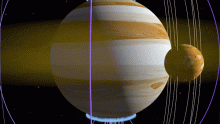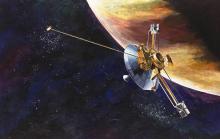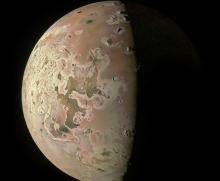Listen to today's episode of StarDate on the web the same day it airs in high-quality streaming audio without any extra ads or announcements. Choose a $8 one-month pass, or listen every day for a year for just $30.
You are here
Changing Spot
Here on Earth, storm systems come and go over a period of days or weeks. On other planets, though, they can last a lot longer. But they can change dramatically.
The best example is the Great Red Spot, on Jupiter, the giant of the solar system. The storm has been around for at least a century and a half, and perhaps a lot longer. In the last few decades, though, it’s gotten smaller — a process that’s picking up speed.
The Great Red Spot is an anticyclone — a high-pressure system. It spins in the opposite direction from hurricanes, which are low-pressure systems.
When first seen, the oval storm spanned about three times the width of Earth from east to west. By 1980, it had dropped to about half that size. And since then, its width has dropped another 40 percent — including 20 percent in just the last decade.
A recent study found that winds on the storm’s edge appear to have increased by five to ten percent — topping out at hundreds of miles per hour.
The results are still being verified. But they suggest that the Great Red Spot could be getting more intense. That could cause it to spin faster, the way a skater spins faster as it pulls in its arms. So in the coming years, the storm could get smaller but more powerful — with an uncertain fate at the end of that process.
We’ll talk about another storm on Jupiter tomorrow. In the meantime, look for Jupiter low in the southeast at first light. It looks like a brilliant star.





